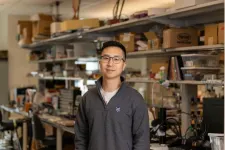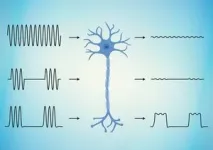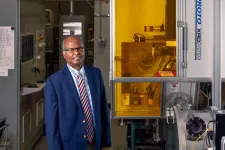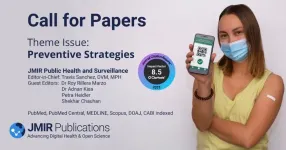(Press-News.org) HOUSTON – (Oct. 10, 2023) – Researchers have long recognized the therapeutic potential of using magnetoelectrics ⎯ materials that can turn magnetic fields into electric fields ⎯ to stimulate neural tissue in a minimally invasive way and help treat neurological disorders or nerve damage. The problem, however, is that neurons have a hard time responding to the shape and frequency of the electric signal resulting from this conversion.
Rice University neuroengineer Jacob Robinson and his team designed the first magnetoelectric material that not only solves this issue but performs the magnetic-to-electric conversion 120 times faster than similar materials. According to a study published in Nature Materials, the researchers showed the material can be used to precisely stimulate neurons remotely and to bridge the gap in a broken sciatic nerve in a rat model.
The material’s qualities and performance could have a profound impact on neurostimulation treatments, making for significantly less invasive procedures, Robinson said. Instead of implanting a neurostimulation device, tiny amounts of the material could simply be injected at the desired site. Moreover, given magnetoelectrics’ range of application in computing, sensing, electronics and other fields, the research provides a framework for advanced materials design that could drive innovation more broadly.
“We asked, ‘Can we create a material that can be like dust or is so small that by placing just a sprinkle of it inside the body you’d be able to stimulate the brain or nervous system?’” said Joshua Chen, a Rice doctoral alumnus who is a lead author on the study. “With that question in mind, we thought that magnetoelectric materials were ideal candidates for use in neurostimulation. They respond to magnetic fields, which easily penetrate into the body, and convert them into electric fields ⎯ a language our nervous system already uses to relay information.”
The researchers started with a magnetoelectric material made up of a piezoelectric layer of lead zirconium titanate sandwiched between two magnetorestrictive layers of metallic glass alloys, or Metglas, which can be rapidly magnetized and demagnetized.
Gauri Bhave, a former researcher in the Robinson lab who now works in technology transfer for Baylor College of Medicine, explained that the magnetorestrictive element vibrates with the application of a magnetic field.
“This vibration means it basically changes its shape,” Bhave said. “The piezoelectric material is something that, when it changes its shape, creates electricity. So when those two are combined, the conversion that you’re getting is that the magnetic field you’re applying from the outside of the body turns into an electric field.”
However, the electric signals magnetoelectrics generate are too fast and uniform for neurons to detect. The challenge was to engineer a new material that could generate an electric signal that would actually get cells to respond.
“For all other magnetoelectric materials, the relationship between the electric field and the magnetic field is linear, and what we needed was a material where that relationship was nonlinear,” Robinson said. “We had to think about the kinds of materials we could deposit on this film that would create that nonlinear response.”
The researchers layered platinum, hafnium oxide and zinc oxide and added the stacked materials on top of the original magnetoelectric film. One of the challenges they faced was finding fabrication techniques compatible with the materials.
“A lot of work went into making this very thin layer of less than 200 nanometers that gives us the really special properties,” Robinson said.
“This reduced the size of the entire device so that in the future it could be injectable,” Bhave added.
As proof of concept, the researchers used the material to stimulate peripheral nerves in rats and demonstrated the material’s potential for use in neuroprosthetics by showing it could restore function in a severed nerve.
“We can use this metamaterial to bridge the gap in a broken nerve and restore fast electric signal speeds,” Chen said. “Overall, we were able to rationally design a new metamaterial that overcomes many challenges in neurotechnology. And more importantly, this framework for advanced material design can be applied toward other applications like sensing and memory in electronics.”
Robinson, who drew on his doctoral work in photonics for inspiration in engineering the new material, said he finds it “really exciting that we can now design devices or systems using materials that have never existed before rather than being confined to ones in nature.”
“Once you discover a new material or class of materials, I think it’s really hard to anticipate all the potential uses for them,” said Robinson, a professor of electrical and computer engineering and bioengineering. “We’ve focused on bioelectronics, but I expect there may be many applications beyond this field.”
Antonios Mikos, Rice’s Louis Calder Professor of Chemical Engineering, professor of bioengineering and materials science and nanoengineering and director of the Biomaterials Lab, Center for Excellence in Tissue Engineering and J.W. Cox Laboratory for Biomedical Engineering, is also an author on the study.
The research was supported by the National Science Foundation (2023849) and the National Institutes of Health (U18EB029353).
-30-
This release can be found online at news.rice.edu.
Follow Rice News and Media Relations via Twitter @RiceUNews.
Peer-reviewed paper:
“Self-rectifying magnetoelectric metamaterials for remote neural stimulation and motor function restoration” | Nature Materials | DOI: 10.1038/s41563-023-01680-4
Authors: Joshua Chen, Gauri Bhave, Fatima Alrashdan, Abdeali Dhuliyawalla, Katie Hogan, Antonios Mikos and Jacob Robinson
https://www.nature.com/articles/s41563-023-01680-4
Image downloads:
https://news-network.rice.edu/news/files/2023/10/230427_BRC-Shoot-Josh-Chen_Gustavo-07776.jpg
CAPTION: Rice University doctoral alum Joshua Chen is lead author on a study published in Nature Materials. (Photo by Gustavo Raskosky/Rice University)
https://news-network.rice.edu/news/files/2023/10/Gauri-Bhave.jpg
CAPTION: Gauri Bhave, a former research scientist in the Robinson lab, is a lead co-author on a study published in Nature Materials. (Photo courtesy of Gauri Bhave)
https://news-network.rice.edu/news/files/2023/10/magnetic-to-electric.jpg
CAPTION: Schematic of neural response for linear magnetic-to-electric conversion (top two conversions) versus nonlinear (bottom third). (Image courtesy of Josh Chen/Rice University)
https://news-network.rice.edu/news/files/2023/10/MNM_pic.jpg
CAPTION: Magnetoelectric nonlinear metamaterials are 120 times faster at stimulating neural activity compared to previously used magnetic materials. (Image courtesy of the Robinson lab/Rice University)
https://news-network.rice.edu/news/files/2023/10/JRobinson_prov.jpg
CAPTION: Jacob Robinson is a professor of electrical and computer engineering and bioengineering at Rice University. (Photo courtesy of the Robinson lab/Rice University)
Related stories:
Rice’s Cherukuri, Robinson to speak at SXSW:
https://news.rice.edu/news/2023/rices-cherukuri-robinson-speak-sxsw
Rice U. bioengineering Ph.D. named Schmidt Science Fellow:
https://news.rice.edu/news/2023/rice-u-bioengineering-phd-named-schmidt-science-fellow
Mikos Receives International Award of the European Society for Biomaterials:
https://bioengineering.rice.edu/news/mikos-receives-international-award-european-society-biomaterials
Wireless activation of targeted brain circuits in less than one second:
https://news.rice.edu/news/2022/wireless-activation-targeted-brain-circuits-less-one-second
Links:
Robinson lab: www.robinsonlab.com
Mikos lab: https://mikoslab.rice.edu/
Biomaterials Lab: https://research.rice.edu/bml/
Center for Excellence in Tissue Engineering: http://tissue.rice.edu/
Rice Neuroengineering Initiative: neuroengineering.rice.edu
Rice Department of Electrical and Computer Engineering: eceweb.rice.edu
Rice Department of Bioengineering: https://bioengineering.rice.edu/
George R. Brown School of Engineering: engineering.rice.edu
Located on a 300-acre forested campus in Houston, Rice University is consistently ranked among the nation’s top 20 universities by U.S. News & World Report. Rice has highly respected schools of Architecture, Business, Continuing Studies, Engineering, Humanities, Music, Natural Sciences and Social Sciences and is home to the Baker Institute for Public Policy. With 4,552 undergraduates and 3,998 graduate students, Rice’s undergraduate student-to-faculty ratio is just under 6-to-1. Its residential college system builds close-knit communities and lifelong friendships, just one reason why Rice is ranked No. 1 for lots of race/class interaction and No. 4 for quality of life by the Princeton Review. Rice is also rated as a best value among private universities by Kiplinger’s Personal Finance.
END
Rice-engineered material can reconnect severed nerves
Magnetoelectric material is first of its kind able to directly stimulate neural tissue
2023-10-10
ELSE PRESS RELEASES FROM THIS DATE:
Houston wins $5 million in DOE funding for high performance superconducting tape projects
2023-10-10
The U.S. Department of Energy recently announced a $10 million investment in three projects to develop novel technologies to manufacture high-performance superconducting tapes in the United States. Two of the projects are built on the foundations of cutting-edge research from the University of Houston.
The DOE values superconductivity because it means zero wasted electricity. Superconductivity, found only in certain materials, allows direct electric current to be conducted with zero resistance and without energy loss. Widely available low cost, high-temperature superconducting (HTS) tapes are used for a broad range ...
Dean Jennifer L. West elected to the National Academy of Medicine
2023-10-10
Jennifer L. West, Ph.D., Dean of the School of Engineering and Applied Science at the University of Virginia, has been elected to the prestigious NATIONAL ACADEMY OF MEDICINE, one of the highest recognitions in health and medicine. The National Academy of Medicine is one of three institutions that make up the National Academies, operating under an 1863 Congressional charter signed by President Lincoln to assemble experts to advise the nation in science and technology.
“It is my honor to welcome this truly exceptional class of new members to the National ...
Automated insulin delivery in women with pregnancy complicated by Type 1 diabetes
2023-10-10
Automated Insulin Delivery in Women with Pregnancy Complicated by Type 1 Diabetes
The New England Journal of Medicine: Hybrid Closed-Loop technology improved maternal glucose levels during pregnancy complicated by type 1 diabetes.
Authors say that hybrid closed-loop technology should now be offered to all pregnant women with type 1 diabetes
For pregnant women with type 1 diabetes, a technology giving insulin doses as informed by a smartphone algorithm, helps them better manage their blood sugars, compared to traditional insulin pumps or multiple daily injections, according to a new randomised trial published in The New England Journal of Medicine ...
Brain & Behavior Research Foundation awards 2023 outstanding achievement prizes to five leading psychiatric researchers
2023-10-10
The Brain & Behavior Research Foundation, the world’s largest private funder of mental health research grants, today announced it is awarding the 2023 Outstanding Achievement Prizes in Mental Health to five scientists for their exceptional work in advancing psychiatric research. The prizewinners will be the featured speakers at the BBRF International Mental Health Research Symposium on October 27, 2023, in New York City, and will receive their awards later that evening at the BBRF International ...
Mount Sinai researchers first to develop age prediction model on human brain tissue using artificial intelligence
2023-10-10
Paper Title: Histopathologic Brain Age Estimation via Multiple Instance Learning
Journal: Acta Neuropathologica, October 10, 2023
Authors: John F. Crary, MD, PhD, Professor of Pathology, Molecular and Cell-Based Medicine, Neuroscience, and Artificial Intelligence and Human Health at the Icahn School of Medicine at Mount Sinai; Kurt W. Farrell, PhD, Assistant Professor of Pathology, Molecular and Cell-Based Medicine, Neuroscience, and Artificial Intelligence and Human Health at Icahn Mount Sinai; Gabriel A. Marx, MD, MS, Resident in Neurology at Icahn Mount Sinai; and other coauthors.
Bottom Line: The aging brain undergoes structural ...
JMIR Public Health and Surveillance call for papers theme issue on preventive strategies
2023-10-10
JMIR Public Health and Surveillance Editor-in-Chief: Travis Sanchez and guest editors Dr. Roy Rillera Marzo, Dr. Adnan Kisa, Petra Heidler and Shekhar Chauhan welcome submissions to a special theme issue examining "Scaling Up Effective Public Health Interventions for Long-Term Population Health Benefits."
This special issue aligns with the journal’s commitment to advancing knowledge in public health and disease prevention. It provides an opportunity to showcase cutting-edge research in preventive strategies, with ...
John D. Carpten, Ph.D., City of Hope’s chief scientific officer, elected to prestigious National Academy of Medicine
2023-10-10
LOS ANGELES — John D. Carpten, Ph.D., chief scientific officer at City of Hope, one of the largest cancer research and treatment organizations in the United States and a leading research center for diabetes and other life-threatening illnesses, was presented with one of the highest honors in health and medicine today when he was elected to the National Academy of Medicine (NAM).
NAM recognized Carpten “for leading the genomics field in understanding how racial and ethnic backgrounds affect cancer predisposition,” sharing that ...
Can immunity from routine vaccines be used to fight cancer?
2023-10-10
A University of Massachusetts Amherst team has demonstrated in theory that a protein antigen from a childhood vaccine can be delivered into the cells of a malignant tumor to refocus the body’s immune system against the cancer, effectively halting it and preventing its recurrence.
The bacteria-based intracellular delivering (ID) system uses a non-toxic form of Salmonella that releases a drug, in this case a vaccine antigen, after it’s inside a solid-tumor cancer cell.
“As an off-the-shelf immunotherapy, this bacterial system has ...
X-rays reveal microstructural fingerprints of 3D-printed alloy
2023-10-10
ITHACA, N.Y. -- Cornell researchers took a novel approach to explore the way microstructure emerges in a 3D-printed metal alloy: They bombarded it with X-rays while the material was being printed.
By seeing how the process of thermomechanical deformation creates localized microscale phenomena such as bending, fragmentation and oscillation in real time, the researchers will be able to produce customized materials that incorporate such performance-enhancing characteristics.
The group’s paper, “Dendritic Deformation Modes in Additive ...
New study offers improved strategy for social media communications during wildfires
2023-10-10
In the last 20 years, disasters have claimed more than a million lives and caused nearly $3 trillion in economic losses worldwide, according to the United Nations.
Disaster relief organizations (DROs) mobilize critical resources to help impacted communities, and they use social media to distribute information rapidly and broadly. Many DROs post content via multiple accounts within a single platform to represent both national and local levels.
Specifically examining wildfires in collaboration with the Canadian Red Cross (CRC), new research from the University of Notre Dame contradicts ...
LAST 30 PRESS RELEASES:
Sleeping in on weekends may help boost teens’ mental health
Study: Teens use cellphones for an hour a day at school
After more than two years of war, Palestinian children are hungry, denied education and “like the living dead”
The untold story of life with Prader-Willi syndrome - according to the siblings who live it
How the parasite that ‘gave up sex’ found more hosts – and why its victory won’t last
When is it time to jump? The boiling frog problem of AI use in physics education
Twitter data reveals partisan divide in understanding why pollen season's getting worse
AI is quick but risky for updating old software
Revolutionizing biosecurity: new multi-omics framework to transform invasive species management
From ancient herb to modern medicine: new review unveils the multi-targeted healing potential of Borago officinalis
Building a global scientific community: Biological Diversity Journal announces dual recruitment of Editorial Board and Youth Editorial Board members
Microbes that break down antibiotics help protect ecosystems under drug pollution
Smart biochar that remembers pollutants offers a new way to clean water and recycle biomass
Rice genes matter more than domestication in shaping plant microbiomes
Ticking time bomb: Some farmers report as many as 70 tick encounters over a 6-month period
Turning garden and crop waste into plastics
Scientists discover ‘platypus galaxies’ in the early universe
Seeing thyroid cancer in a new light: when AI meets label-free imaging in the operating room
Neutrophil-to-lymphocyte ratio may aid risk stratification in depressive disorder
2026 Seismological Society of America Annual Meeting
AI-powered ECG analysis offers promising path for early detection of chronic obstructive pulmonary disease, says Mount Sinai researchers
GIMM uncovers flaws in lab-grown heart cells and paves the way for improved treatments
Cracking the evolutionary code of sleep
Medications could help the aging brain cope with surgery, memory impairment
Back pain linked to worse sleep years later in men over 65, according to study
CDC urges ‘shared decision-making’ on some childhood vaccines; many unclear about what that means
New research finds that an ‘equal treatment’ approach to economic opportunity advertising can backfire
Researchers create shape-shifting, self-navigating microparticles
Science army mobilizes to map US soil microbiome
Researchers develop new tools to turn grain crops into biosensors
[Press-News.org] Rice-engineered material can reconnect severed nervesMagnetoelectric material is first of its kind able to directly stimulate neural tissue







